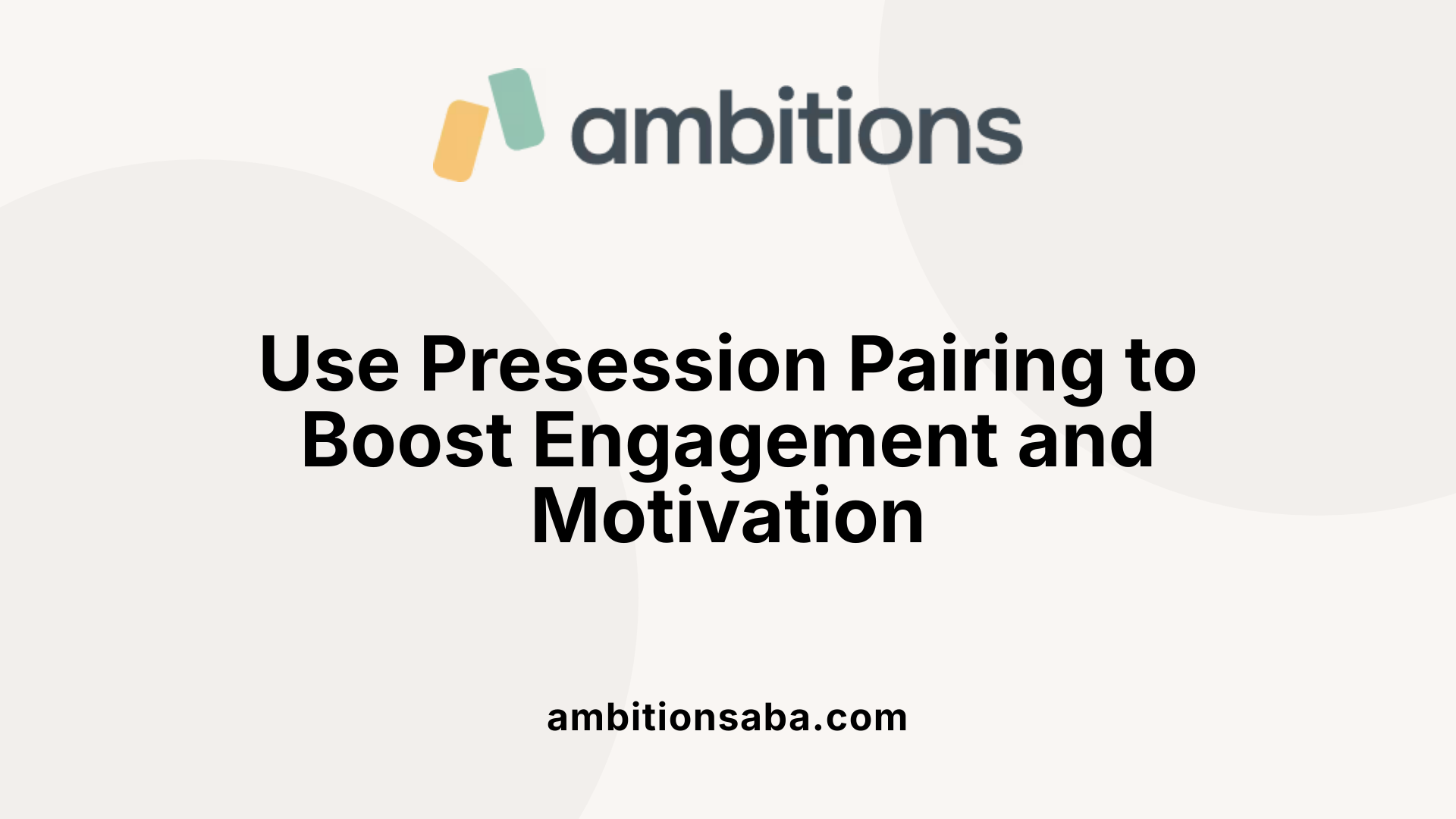Understanding the Role of Rapport in Autism Interventions
In the realm of Applied Behavior Analysis (ABA) therapy, fostering a strong, positive relationship between the therapist and the child with autism spectrum disorder (ASD) is foundational. Pairing, a strategic rapport-building process, is essential not only to connect with the child but also to maximize therapeutic outcomes. This article explores how pairing contributes to rapport and why it is critical for the success of ABA interventions.
Applied Behavior Analysis: Foundation for Autism Support
What is Applied Behavior Analysis (ABA) therapy and how is it used to support individuals with autism?
Applied Behavior Analysis (ABA) therapy is a scientifically grounded approach that uses behavior modification techniques to support individuals with autism. It focuses on understanding the relationship between antecedents, behaviors, and consequences to promote positive change. Structured interventions designed by trained professionals emphasize positive reinforcement, rewarding desirable behaviors to encourage their recurrence.
ABA tailors its goals to each individual's unique needs, such as communication, social skills, daily living, and self-care. Early intensive ABA intervention, often involving 25-40 hours per week, has been shown to improve adaptive functioning and emotional development significantly. Caregiver involvement is also key to supporting skill generalization beyond therapy sessions. As the field evolves, ABA continues to respect neurodiversity and prioritize meaningful participation and independence for individuals with autism.
What are the main goals and benefits of ABA therapy in autism treatment?
The primary goals of ABA therapy are to increase positive, functional behaviors and decrease harmful or challenging ones. This includes improving communication, socialization, attention, memory, academic skills, and daily living competencies. The ultimate aim is to enhance independence and quality of life.
ABA applies evidence-based techniques such as prompting, environmental modifications, and strategic use of reinforcement. Intensive early intervention supports notable developmental gains, fostering improved social skills and reducing problem behaviors. The benefits also include helping children better navigate real-world situations and fostering cooperation during therapy.
Who typically provides ABA therapy, and what kind of professionals are involved?
ABA therapy is usually delivered by trained professionals specializing in behavior analysis. Board Certified Behavior Analysts (BCBAs) develop and oversee individualized treatment plans based on detailed behavioral assessments. Registered Behavior Technicians (RBTs) or therapists implement daily therapy sessions under BCBA supervision.
Additionally, interdisciplinary collaboration with speech therapists, occupational therapists, and clinical psychologists may support holistic development. Together, these professionals ensure therapy meets each individual's needs and promotes meaningful progress in various areas of functioning.
The Essence of Pairing: Building the Therapeutic Alliance

What is Pairing in ABA Therapy?
Pairing is a foundational technique used in Applied Behavior Analysis (ABA) therapy, especially in early intervention for children with autism spectrum disorder (ASD). It involves associating the therapist or caregiver with positive experiences by engaging the child with preferred items, activities, or social interactions. The primary goal is to build trust and create a positive, enjoyable relationship, making the therapist a source of reinforcement and increasing the child's motivation to engage.
How Does Pairing Start?
Initial pairing sessions deliberately avoid demands or any non-preferred activities. Instead, the therapist focuses on following the child’s lead, offering activities the child enjoys such as playing with favored toys, participating in sensory-social play, or sharing fun communication moments. This approach fosters a positive connection and encourages the child to seek interaction without pressure.
What Role Do Preferred Stimuli and Social Interactions Play?
Preferred stimuli are central to successful pairing. Identifying these through assessments or observation helps therapists tailor interactions using multiple highly motivating items or activities. Social interactions, such as praise, physical play, and engaging communication, complement the use of preferred materials by making the instructor an essential and enjoyable part of the experience. This combination increases engagement and reinforces the bond between child and therapist.
Why Avoid Demands Initially?
Avoiding demands during the first stages of rapport-building prevents escape-motivated behaviors that can undermine the child’s comfort and cooperation. Gradually introducing demands only after a positive relationship is established supports sustained engagement and minimizes resistance. The therapist can then fade in simple, meaningful tasks and increase complexity over time while maintaining the motivation fostered by early pairing.
By integrating these steps, pairing lays the groundwork for effective therapy, promoting cooperation and reducing disruptive behaviors while making the therapeutic environment welcoming and supportive for children with ASD.
Strategic Implementation of Pairing to Enhance Engagement

What is Presession Pairing and How Does it Impact Therapy?
Presession pairing (PSP) is a technique used before therapy sessions, involving engaging the child with behavior-specific praise, social interactions, and preferred activities without placing demands. Studies suggest that PSP can positively influence child preferences and behaviors during discrete-trial instruction by helping reduce disruptive behaviors, such as negative vocalizations. It fosters an inherent child preference for interactive elements that make therapy more enjoyable.
How are Preferences Identified to Guide Pairing?
Accurate identification of preferred reinforcers is essential to effective pairing. Therapists use preference assessments and careful observation to find multiple items, activities, or social interactions that motivate the child. These might include sensory-social play, favorite toys, snacks, or outdoor activities, which are then used strategically during pairing to maintain high motivation.
How Does Following the Child’s Lead Increase Engagement?
Engagement is maximized when therapists follow the child's motivation—choosing activities and interactions that the child initiates or clearly enjoys. This approach, often referred to as "capturing motivation," makes the instructor a critical and welcome part of the activity. It strengthens the child's positive association with the therapist and the therapy setting.
Why are Dynamic Interaction and Reinforcement Important?
Building rapport is an ongoing, dynamic process. Therapists continuously adjust the type and timing of reinforcements, strategically present preferred items, and pay close attention to the child’s cues and interests. Such responsiveness ensures the interaction remains engaging and meaningful, creating a positive, trusting bond.
How Are Demands Introduced Gradually in Pairing?
To avoid escape-motivated behavior and maintain engagement, demands are faded in slowly. Therapists start with easy, meaningful tasks, gradually increasing difficulty over time. If the child's engagement diminishes or disruptive behavior resurges, pairing procedures are reintroduced to restore rapport. This careful balance maintains the child's cooperation and promotes successful skill acquisition.
Challenges and Best Practices in Pairing and Rapport Maintenance
Timing and Balancing Pairing with Instructional Demands
Effective pairing requires careful timing to ensure that the therapist becomes associated with positive experiences before introducing instructional demands. Typically, initial pairing sessions—1 to 2 in number—focus solely on engaging the child with preferred activities, avoiding any non-preferred tasks or requests. Gradually, demands are faded in starting with easy, meaningful tasks to maintain engagement and prevent escape-motivated behaviors.
Recognizing and Responding to Deteriorated Rapport
Rapport is fragile and can deteriorate if not maintained. Signs such as decreased engagement, negative emotional responses, or increased disruptive behaviors indicate that the positive association may be weakening. In these cases, re-establishing rapport through renewed pairing sessions is essential to regain the child's motivation and trust.
Adapting Pairing to Individual Preferences and Developmental Levels
Since children with autism spectrum disorder have diverse interests and abilities, pairing strategies must be individualized. Therapists should conduct preference assessments and observe the child's cues closely to select optimal reinforcers. Additionally, developmental and communication levels inform how pairing is implemented, always prioritizing following the child's lead to foster genuine connection.
Ongoing Assessment and Flexibility
Pairing is not a one-time event but an ongoing process requiring regular reassessment of the child's preferences and engagement. Flexibility in adjusting activities, reinforcers, and interaction styles helps sustain motivation and reinforce the positive relationship.
Overcoming Challenges with Consistency and Patience
Challenges in pairing, such as balancing demands and changes in child preferences, necessitate therapist patience and consistent implementation. Persistence, combined with strategic, gradual introduction of tasks, allows the therapeutic relationship to strengthen and supports better engagement and behavioral outcomes over time.
Impact of Strong Rapport on Therapy Outcomes and Child Behavior

How Does Rapport Influence Therapy Effectiveness?
Establishing a strong rapport between the therapist and the child with autism is fundamental to the success of ABA therapy. Positive relationships foster mutual trust and understanding, which increase the child's willingness to participate and attend to the therapist. Studies show that rapport-building procedures, like presession pairing (PSP), connect the therapist to preferred stimuli, effectively making the therapist a source of positive experiences rather than just a figure delivering instructions.
Can Pairing Help Reduce Disruptive Behaviors?
Implementation of pairing has been linked to reductions in disruptive behaviors such as negative vocalizations during discrete-trial instruction. By engaging in preferred activities before sessions—without placing demands—children display fewer escape-motivated responses. Although further research is needed to clarify causality, initial evidence supports the role of rapport-building in managing problem behaviors.
How Does Rapport Increase Cooperation and Motivation?
Rapport-building leverages child preferences identified through assessments to engage the child actively and follow their lead. Using favorite toys, sensory-social play, and social interaction, therapists make themselves a critical part of enjoyable activities. This strategy increases motivation for learning and cooperation, as children are more inclined to follow demands gradually introduced after positive associations with the therapist are established.
What Constitutes a Positive, Engaging Therapeutic Environment?
Creating an environment that feels friendly rather than clinical transforms therapy into a social interaction filled with fun and reinforcement. Activities like games, outdoor play, and humor contribute to making therapy sessions enjoyable. Attention to the child’s cues, interests, and emotional responses—such as excitement when interacting with the therapist—helps maintain engagement and strengthens the therapeutic bond.
What Are the Long-Term Benefits of Maintaining Rapport?
Sustained rapport ensures the child seeks the therapist naturally, supports ongoing motivation, and facilitates generalization of learned skills beyond therapy sessions. Additionally, ongoing relationship-building can prevent regression into disruptive behaviors by re-establishing positive associations when engagement diminishes. Ultimately, continuous rapport-building contributes to better therapy outcomes and improved behavioral skills in children with autism.
The Critical Role of Pairing in Successful ABA Therapy
Pairing stands as a pivotal element in building meaningful rapport between therapists and children with autism. By associating therapists with preferred activities and positive reinforcement, pairing cultivates trust, engagement, and motivation essential for effective ABA therapy. This foundation not only encourages cooperation and reduces challenging behaviors but also supports skill acquisition and generalization beyond therapy sessions. Ongoing, adaptive rapport-building ensures that the therapeutic relationship remains strong, enabling children to flourish in learning and social interactions. Embracing the principles of pairing within ABA underscores its importance as a transformative practice in autism treatment.
References
- Effects of Presession Pairing on Preference for Therapeutic ...
- Building Rapport using Strategies to Promote Pairing
- The Importance of Building Rapport in ABA
- The Magic of Pairing in ABA: Building Bonds That ...
- The ABCs of ABA: What is Pairing & Building Rapport?
- Evaluation of a rapport‐building intervention for early ...
- Pairing: Building Relationships Before Placing Demand
- Applied Behavior Analysis (ABA)
- Applied Behavior Analysis (ABA)



